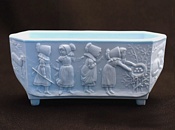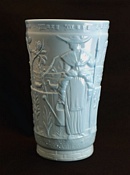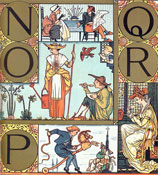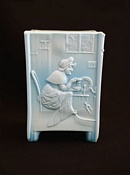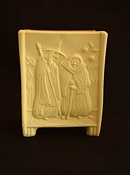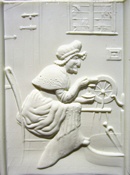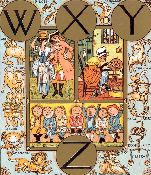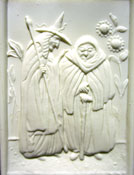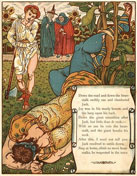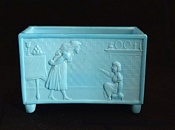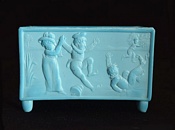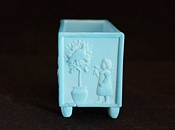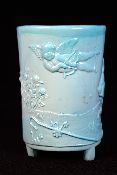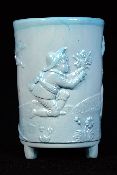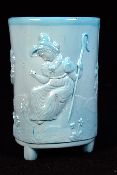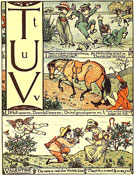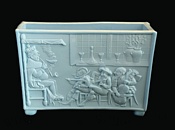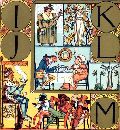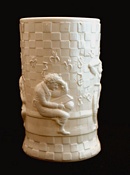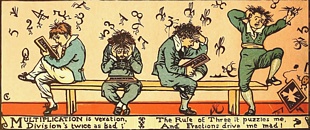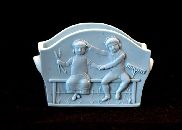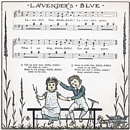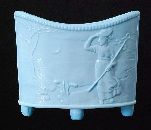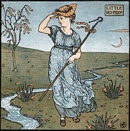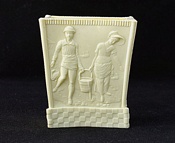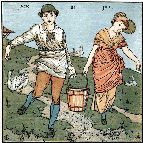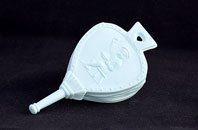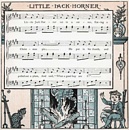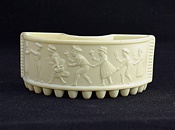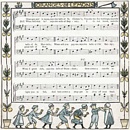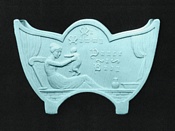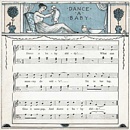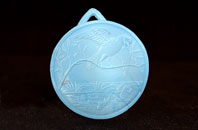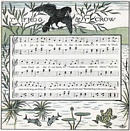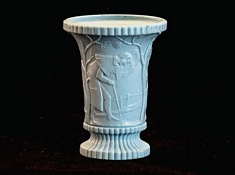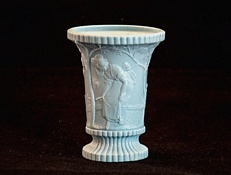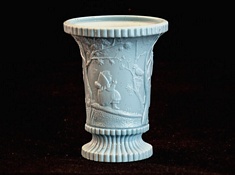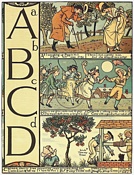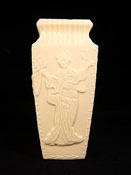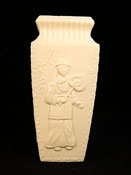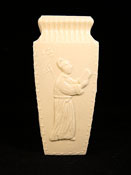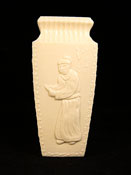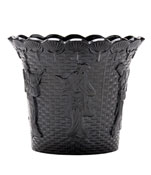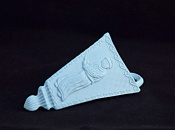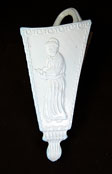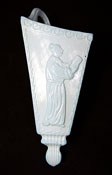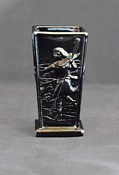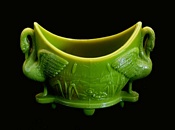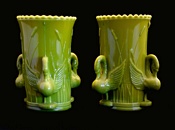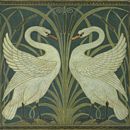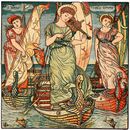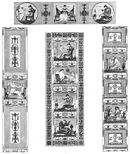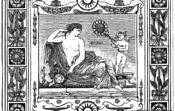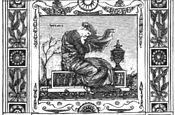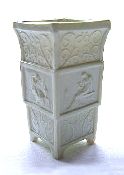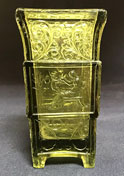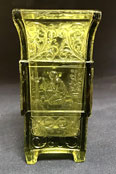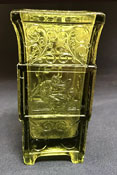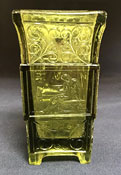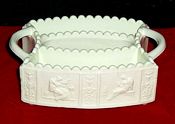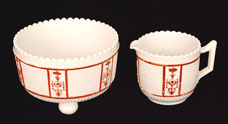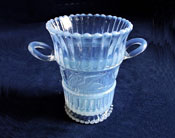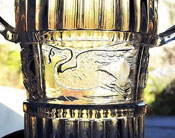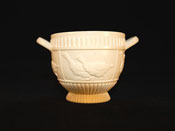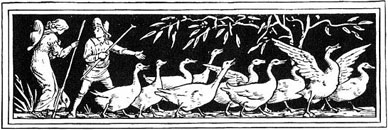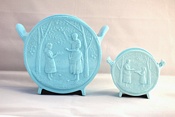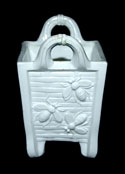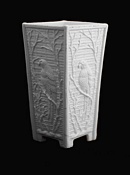Sowerby Nursery Rhyme and Pictorial Glass
The main production of the Sowerby glass house was clear pressed glass household and utility items. In 1876 the Sowerby company patented a new kind of glass which they called vitro-porcelain. This was an opaque glass which could be made in a number of different colours. In 1877 Sowerby started to produce a range of small decorative objects in this new glass, taking the form of small baskets and vases many of which had classical and aesthetic motifs. A number of their objects were decorated with characters taken directly from children's nursery rhyme books produced by eminent Victorian artist Walter Crane. This page shows sources used for the 'Nursery Rhyme' and other pictorial Sowerby glass.
For research I have used the books in the BOOKS page on this site, I refer to the book by the author's surname and to which I reference where appropriate. I have also used pattern books, other articles and photographs of my own and museum collections where necessary. Special thanks to Fred Cooper for images from the Glass Message Board Sowerby gallery. Links to external pages are in BLUE, these will open in a new window.
Content
- J G Sowerby and Walter Crane
- Nursery Rhyme Glass - from Walter Crane books
- Pattern 1219 - Elizabeth, Elspeth, Betsy & Bess
- Pattern 1220 - Mistress Mary Quite Contrary
- Pattern 1225 - Cross Patch
- Pattern 1226 - Nievie, Nievie, Nicknack / Three Children Sliding / Xmas Gifts
- Pattern 1227 - Valentine
- Pattern 1232 - Old King Cole
- Pattern 1235 - Multiplication
- Pattern 1260 - Lavender's Blue
- Pattern 1263 - Little Bo Peep
- Pattern 1281 - Jack and Jill
- Pattern 1285 - Little Jack Horner
- Pattern 1293/1293.5 - Oranges and Lemons
- Pattern 1294 - Dance a Baby
- Pattern 1296 - Ye Frog & Ye Crow
- Pattern 1300 - Pippin Hill
- Pictorial Glass - Walter Crane designs
- Other Pictorial Glass
- Notes on Nursery Rhyme and Pictorial Glass
J G Sowerby and Walter Crane
As well as being the owner of the Sowerby glass factory, John George Sowerby was also a talented artist and illustrator and as such was responsible for many of the designs of the small objects made from his new vitro-porcelain glass. Some of the most sought after items of Sowerby glassware those which collectors call 'Nursery Rhyme Glass', small vases, wall pockets and flower holders on which are depictions of Victorian nursery rhymes.
As an artist, in 1881 Sowerby collaborated with Thomas Crane to illustrate and produce a childrens book, 'At Home'. The book was published by Marcus Ward & Co where Thomas Crane was art director. Walter Crane, the brother of Thomas Crane was also an artist, illustrator and prolific creator of childrens books. In 1863 the engraver and printer Edmund Evans hired Walter Crane as an illustrator and in 1865 they worked in partnership on children's 'toy books' of nursery rhymes and fairy tales. From 1865 to 1876 Crane and Evans produced two to three books a year, about 50 books in total.
Most of the pictorial pieces produced by Sowerby were based on the designs taken from illustrations from the childrens books produced by Walter Crane. John George Sowerby probably knew Walter Crane through his brother Thomas and must have used the designs with Crane's permission, although the exact circumstances of the commission are not known. What is known is that none of the designs for the Crane illustrated pieces were registered, probably because the designs already had a Crane copyright.
With the odd exceptions, most of the designs are taken from the following books:
An Alphabet of Old Friends - published in 1874
Aladdin; Or, The Wonderful Lamp - published in 1875
Baby's own Alphabet - published in 1875
Jack and the Beanstalk - published in 1875
The Baby's Opera - published in 1877
Vitro porcelain was introduced in 1876 and the nursery rhyme designs were introduced early in the production. Although nursery rhyme pieces carry a Sowerby trade mark they will not have a registry mark and it is only possible to say when the designs were first introduced by the pattern numbers in the pattern books.
The first 'nursery rhyme' pattern is number 1188 which along with pattern numbers 1206.5 and 1218 show oriental characters which appear to have been inspired by, but are not exact copies of characters from Aladdin; Or, The Wonderful Lamp.
The designs of the remaining nursery rhyme patterns starting with number 1219 Elisabeth, Elspeth, Betsy & Bess and finishing with pattern number 1300 'Pippin Hill' are all virtually exact copies of the original Walter Crane illustrations..
(Pattern number 1219 falls between 1214, design registered 22 March 1877 and 1224, registered 31 May 1877, so the design for 1219 was introduced between these dates. Pattern number 1300 equates to pattern number 1301 which was registered on 4th November 1878).
Sowerby also used other Walter Crane designs which were not based on Crane's nursery rhyme books, and other designs which I have included at the end.
We will now look at the designs, and their sources based on pattern numbers. All of these designs appear in the 1882 pattern book IX
Nursery Rhyme Glass - from Walter Crane books
Pattern 1219 - Elizabeth, Elspeth, Betsy & Bess
An Alphabet of Old Friends 'E'
Elizabeth, Elspeth, Betsy, and Bess,
They all went together to seek a bird's nest
They found a bird's nest with five eggs in;
They all took one, and left four in.
The end pieces feature a sheep one end and a toad the other. I cannot find specific images relating to these.
Pattern 1220 - Mistress Mary Quite Contrary
An Alphabet of Old Friends 'M'
Mistress Mary,
Quite contrary,
How does your garden grow?
With silver bells,
And cockle shells.
And cowslips all of a-row.
The text 'Mistress Mary quite contrary how does your garden grow' is around the top of the beaker
A similar figure also appears in The Baby's Opera (pg 15), My Lady's Garden.
Pattern 1225 - Cross Patch
An Alphabet of Old Friends 'X' and Jack and the Beanstalk
Cross X patch,
Draw the latch,
Take a cup
Sit by the fire and spin:
And drink it up,
Then call the neighbours in.
This spill vase is generally known as 'Cross Patch' as this figure appears on one side. The other side of the vase has two old ladies with sunflowers in the background. One looks like a witch with a staff and snakes in her hat, the other with a walking stick and pebble glasses. These figures appear in Jack and the Beanstalk (illustrated by Walter Crane) London: George Routledge and Sons, 1875. Please see the picture above.
The 'neighbours' can be seen at the window in the picture and on the glass.
Pattern 1226 - Nievie, Nievie, Nicknack / Three Children / Xmas Gifts
Baby's own Alphabet, 'N', 'T' & 'X'.
| Nievie, Nievie, Nicknack
Which hand willye tak'? Tak' the right, or tak' the wrang I'll beguile ye, if I can |
Three children sliding on the ice.
Upon a summer's day As it fell out, they all fell in. The rest they ran away. |
Xmas Gifts.
The first day of Xmas My mother sent to me A partridge in a pear tree. |
This trough is unusual in that it features three different rhymes from 'Baby's Own Alphabet.
Nievie is the Scottish word for fist. This rhyme can be used for either a counting-out rhyme for choosing "It" or as a guessing game where you hold both hands behind your back with a prize in one, the child picks the left or right hand trying to guess which one has the prize.
Xmas Gifts comes from the first line of the song 'The Twelve Days of Christmas'
The rhyme 'Three Children (Sliding)' also appears in The Baby's Opera (Page 47).
Pattern 1227 - Valentine
Baby's own Alphabet, 'V'
The Rose is red,
The Violet's blue,
The pink is sweet,
And so are you.
Pattern 1232 - Old King Cole
An Alphabet of Old Friends 'K'
King Cole was a merry old soul,
And a merry old soul was he.
He called for his pipe, and he called for his bowl,
And he called for his fiddlers three.
Every fiddler had a fiddle,
And a very fine fiddle had he;
Twee, tweedle dee, tweedle dee, went the fiddlers.
Oh, there's none so rare
As can compare
With King Cole and his fiddlers three!
The window ledge glasses and pictures above the musicians, which are
not in the picture, has been added on the glass.
There is no griffon on the King's 'throne' on the glass.
Pattern 1235 - Multiplication
Baby's Own Alphabet 'M'
MULTIPLICATION is vexation,
Division's twice as bad;
The Rule of Three it puzzles me,
And Fractions drive me Mad!
Pattern 1260 - Lavender's Blue
The Baby's Opera Page 17
Lavender’s blue, diddle, diddle!,
Lavender’s green;
When I am king, diddle, diddle!
You shall be queen.
There are as many as thirty verses to Lavender's Blue and many variations of each verse. More information on Wikipedia
Pattern 1263 - Little Bo Peep
The Baby's Opera Page 37
Little Bo-Peep, she lost her sheep,
And didn’t know where to find them;
Let them alone, they’ll all come home
And bring their tails behind them.
The moon on the glass has been moved from it's original position in the picture.
Pattern 1281 - Jack and Jill
The Baby's Opera Page 53
Jack and Jill went up the hill
To fetch a pail of water;
Jack fell down and broke his crown,
And Jill came tumbling after.
Pattern 1285 - Little Jack Horner
The Baby's Opera Page 31
Little Jack Horner sat in a corner,
Eating a Christmas pie;
He put in his thumb, and pulled out a plum,
And said, “What a good boy am I!”
On the music page in the Baby's Opera (as above) Little Jack Horner is shown in the right hand bottom corner.
Above him on the wall are the bellows that Sowerby have used for their glass.
Pattern 1293/1293.5 - Oranges and Lemons
The Baby's Opera Page 13
Oranges and lemons, says the bells of St. Clemen’s;
You owe me five farthings, says the bells of St. Martin’s;
When will you pay me, says the bells of Old Bailey;
When I grow rich, says the bells of Shoreditch;
When will that be? says the bells of Stepney;
I do not know, says the great bell of Bow.
Here comes a candle to light you to bed,
And here comes a chopper to chop off your head.
Origins of the Oranges and Lemons rhyme from Wikipedia
Pattern 1294 - Dance a Baby
The Baby's Opera Page 54
Dance a baby diddy!
What can mammy do wid’e?
Sit in her lap,
Give it some pap,
And dance a baby diddy!
Pattern 1296 - Ye Frog & Ye Crow
The Baby's Opera Page 26
A jolly fat frog lived in the river swim, O!
A come-ly black crow lived on the river brim, O!
"Come on shore, come on shore,"
Said the crow to the frog, and then, O!
"No, you'll bite me, "Said the frog to the crow again, o!
Pattern 1300 - Pippin Hill
The Baby's own Alphabet 'A' & 'C'
| Letter 'A'
As I was going up Pippin Hill There I met a pretty miss, Pippin Hill was dirty, And she dropped me a curtsy. |
Letter 'C'
Cuckoo, (on the) cherry tree Come down & tell me How many years I have to live. |
There are two rhymes pictured on this vase, both are from The Baby's own Alphabet.
Pictorial Glass - Walter Crane designs
Pattern numbers 1188, 1206.5 and 1218 - "Mikado"/Aladdin
These designs incorporate 'oriental' figures and are generally referred to as 'Mikado' pieces
The long running Mikado comic opera by Gilbert and Sullivan opened in London in 1885. These Sowerby designs date from 1880 so they are unlikely to be from the Mikado.
They are more likely based on the characters in Walter Crane's 'Aladdin; Or, The Wonderful Lamp'', published in 1875.
Unlike other nursery rhyme depictions, the pictures on all three pieces are inspired by, but are not exact copies of the characters in the book.
Pattern 1188, small mould blown vase. Each side shows a different figure with 'Japanese' numerals.
Pattern 1206.5, large flower pot, registered 19 March 1877 (RD 308713)
Pattern 1218, triangular, hanging hair tidy. Figures on two sides, these same two figures appear on pattern 1188. The back of the tidy has a 'stippled' surface.
With low pattern numbers (1206.5 was registered in 1877), these are some of the first pictorial pieces produced by Sowerby.
Pattern 1234 - "The Shepherd and the Hunter"
This design has previously been called "The Good Shepherd", I have called it "The Shepherd and the Hunter" which seems more apt.
The designs on this pattern are not recorded Walter Crane pictures, but bear striking similarities to some of Crane's other illustrations. Crane produced many children's book so it is possible that these characters may come from a previously unrecorded book.
Pattern 1234 falls between 1232 "Old King Cole", the design of which is from "An Alphabet of Old Friends" published in 1874 and 1235 "Multiplication" which is from "Baby's own Alphabet", published in 1875. So it is fairly safe to assume the pictures are from this date 1874/5
Two sides show a shepherd with a crook, the other two sides show what appears to be a hunter dressed in medieval clothing of tunic and hose with a pillbox hat. The hunter is holding a spear of the sort typically used for hunting wild boar or bears. The figure appears to be indicating someone to 'wait' or be quiet.
Similar Shepherd in:
Baby's Own Aesop, Aesop's Fable - The Eagle and the Crow from 1886, this date is too late for this piece of glass.
Patterns 1328 & 1436 - "Swan Trough and Vase"
Double ended swan 'trough' and vase with three swans.
The design is similar to the swans on the ships in "I saw Three Ships" from " A Baby's Opera", but it is more like Walter Crane's wallpaper design "Swan Rush and Iris". This is one of Walter Crane's earliest designs for wallpaper, created in 1875.
The trough has a Sowerby mark, the vase has a Sowerby but also a registered design mark for the 14th August 1879 (RD 338296).
Patterns 1404, 1409 & 1445 - "Designs from tiles by Maw & co"
A series of tiles depicting the 'Seasons' and 'Times of Day' were commissioned from Walter Crane by Maw & co in 1878.
Sowerby used scenes from these tiles on three patterns, 1404, 1409 and 1445.
Pattern number 1404 bears a registration mark for April 1879.
Pattern number 1445 consists of two items, a sugar and cream, with a similar if not direct copy of a pattern from the 1878 tile set.
Pattern 1408 - "Crane with Snake vase"
Pattern 1408, small vase decorated with a crane with a snake in beak, this vase has a design registration for 28 April 1879 (RD 334637)
Walter Crane used a 'crane' as part of his signature and often included the bird in his drawings and paintings.
The vase has a stylised flying crane with what appears to be a snake in it's beak. I have been unable to find the figure in any of Crane's books.
Pattern 1354 - "Geese vase"
Pattern 1354, small vase decorated with geese, this vase has a design registration for 23 December 1878 (RD 330604)
I have been unable to find this specific design in any of Crane's books, but similar geese do appear in "Household Stories, from the collection of the bros: GRIMM" the "Goose Girl", page 17.
This book contains stories by the Grimm brothers, illustrated by Walter Crane and was published in 1882.
Geese also appear in Baby's Own Aesop published in 1883.
Other Pictorial glass
Patterns 1268/1269 - "Picking Apples"
This is not a Walter Crane design. The Arts and Crafts movement popularized one-of-a-kind, hand-crafted objects. In the 1870's china painting was a fashionable artistic endeavour for wealthy young women to pursue as a 'hobby'.
This design, registered in October 1877, depicts a female figure and child standing under trees in an orchard. Cottle - Page 69 - tells us that the scene was copied from a hand painted porcelain plate entitled 'Gathering Apples'.
The plate was painted by Miss E. Howard in 1877 and was exhibited in Howell & James' annual pottery and porcelain exhibition which was held at their showroom in Regent Street in London.
From the August 1877 Pottery Gazette and Glass Trades Review - with an illustration of the plate was the report that whilst neither 'Gathering Apples' nor its companion piece 'At the Fountain' won the major prize of a Gold Medal 'they deserved the prize they have obtained'.
As an artist, perhaps J G Sowerby was a judge at these exhibitions or maybe the prize was to have your design put into production. How the design ended up on a Sowerby glass ornament, as yet, we do not know.
Pattern 1213 - "Vase with Bees"
Pattern 1213, small vase decorated with bees, this vase has a design registration for 22 March 1877 (RD 308715)
Pattern 1217 - "Vase with Parrots"
Pattern 1217 vase, in two sizes, decorated with parrots, this vase has a design registration for 31 May 1877 (RD 310597)
Notes on Nursery Rhyme and Pictorial Glass
Many of JG Sowerby's other designs display Japanese and 'aesthetic' influences,
these include bamboo, sunflower and peacock motifs.
The peacock, especially associated with the Aesthetic Movement of the 1880's and popular in Japanese art
at that time, was extensively used in the decoration
on Sowerby wares and of course the peacock's head was also used as the Sowerby trade mark.
As this is a page essentially to show Nursery Rhyme and pictorial motifs I have not included these other designs. Maybe another day.
It will be seen that the nursery rhyme pieces with only one picture, for example a vase, the picture on the reverse side is usually a mirror image of the first side.
Many of the nursery rhymes are still familiar today, Old King Cole, Oranges and Lemons, Little Bo Peep, whereas others have been more or less forgotten.
If you collect Sowerby glass you will know that some patterns are more common than others. Oranges and Lemons, Elizabeth, Elspeth, Betsy & Bess, Cross Patch, Old King Cole, are still frequently seen, others like Dance a Baby and Ye Frog & Ye Crow are now quite rare to find. This may reflect the popularity of the nursery rhyme at the time they were being sold in the 1880's.
It must be remembered that these pieces are quite small, most being less than 6inches (15cm) in height or width. They were mass produced and, as can be seen from some of the pictures, the images on the glass are not always crisp and there are usually 'firing' marks, cracks produced during the cooling process. The appeal of these pieces and other Sowerby vito-porcelain is in the 'design' and the colours in which they were produced. The pictorial and other pieces with aesthetic or Japanese influenced surface decoration are usually better to collect in plain colours such as turquoise or Queens Ivory ware where the sometimes very intricate details of the designs are easier to see.

